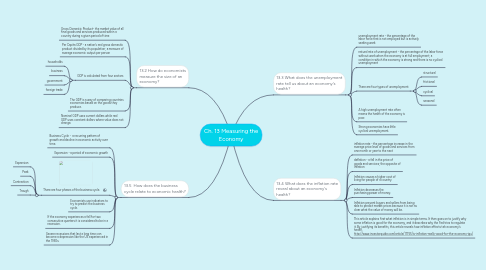Ch. 13 Measuring the Economy
by Hannah Sivertson


1. 13.2 How do economists measure the size of an economy?
1.1. Gross Domestic Product- the market value of all final goods and services produced within a country during a given period of time
1.2. Per Capita GDP - a nation’s real gross domestic product divided by its population; a measure of average economic output per person
1.3. GDP is calculated from four sectors
1.3.1. households
1.3.2. business
1.3.3. government
1.3.4. foreign trade
1.4. The GDP is a way of comparing countries economies based on the goods they produce.
1.5. Nominal GDP uses current dollars while real GDP uses constant dollars where value does not change.
2. 13.3 What does the unemployment rate tell us about an economy's health?
2.1. unemployment rate - the percentage of the labor force that is not employed but is actively seeking work
2.2. natural rate of unemployment - the percentage of the labor force without work when the economy is at full employment; a condition in which the economy is strong and there is no cyclical unemployment
2.3. There are four types of unemployment
2.3.1. structural
2.3.2. frictional
2.3.3. cyclival
2.3.4. seasonal
2.4. A high unemployment rate often means the health of the economy is poor.
2.5. Strong economies have little cyclical unemployment.
3. 13.4 What does the inflation rate reveal about an economy's health?
3.1. inflation rate - the percentage increase in the average price level of goods and services from one month or year to the next
3.2. deflation - a fall in the price of goods and services; the opposite of inflation
3.3. Inflation causes a higher cost of living for people of a country.
3.4. Inflation decreases the purchasing power of money.
3.5. Inflation prevent buyers and sellers from being able to predict market prices because it is not as clear what the value of money will be.
3.6. This article explains first what inflation is in simple terms. It then goes on to justify why some inflation is good for the economy, and it describes why the Fed tries to regulate it. By justifying its benefits, this article reveals how inflation affects teh economy's health. http://www.investorguide.com/article/11755/is-inflation-really-good-for-the-economy-igu/
4. 13.5 How does the business cycle relate to economic health?
4.1. Business Cycle - a recurring pattern of growth and decline in economic activity over time.
4.2. Expansion - a period of economic growth
4.3. There are four phases of the business cycle.
4.3.1. Expansion
4.3.2. Peak
4.3.3. Contraction
4.3.4. Trough
